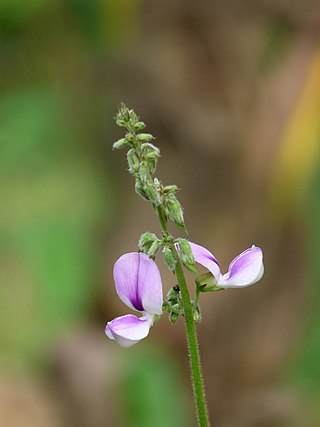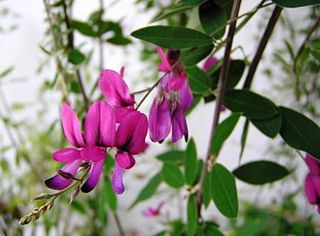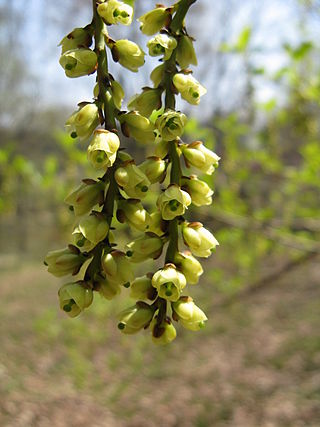
Aralia, or spikenard, is a genus of the family Araliaceae, consisting of 68 accepted species of deciduous or evergreen trees, shrubs, and rhizomatous herbaceous perennials. The genus is native to Asia and the Americas, with most species occurring in mountain woodlands. Aralia plants vary in size, with some herbaceous species only reaching 50 centimetres (20 in) tall, while some are trees growing to 20 metres (66 ft) tall.

Pueraria is a genus of 15–20 species of legumes native to south, east, and southeast Asia and to New Guinea and northern Australia. The best known member is kudzu, also called Japanese arrowroot. The genus is named after 19th century Swiss botanist Marc Nicolas Puerari.

Lespedeza is a genus of some 45 species of flowering plants in the pea family (Fabaceae), commonly known as bush clovers or Japanese clovers (hagi). The genus is native to warm temperate to subtropical regions of eastern North America, eastern and southern Asia and Australasia.

Nephrophyllidium is a monotypic genus of aquatic flowering plants in the family Menyanthaceae. The sole species is Nephrophyllidium crista-galli. They are wetland plants with basal reniform and crenate leaves. Flowers are five-parted and white, and the petals are adorned with lateral wings and a midline keel. Nephrophyllidium is most nearly related to Menyanthes, which is very similar in habit. The genus name is derived from the kidney-shaped leaves, and the specific epithet refers to the curled petal edges.

Nomocharis is a genus of flowering plants in the family Liliaceae. It consists of about 7 species native to montane regions of western China, Myanmar, and northern India. They are similar to Lilium, with one of the more obvious differences being the flowers being more shallow or sometimes flat.

Daphniphyllum is the sole genus in the flowering plant family Daphniphyllaceae and was described as a genus in 1826. The genus includes evergreen shrubs and trees mainly native to east and southeast Asia, but also found in the Indian Subcontinent and New Guinea.

Campylotropis is a genus of flowering plants in the legume family, Fabaceae. It includes 41 species of shrubs native to Asia, ranging from the Himalayas to Indochina, China, Taiwan, Mongolia, and Korea, as well as Java and the Lesser Sunda Islands. Typical habitats include seasonally-dry tropical montane forests to temperate forest, woodland, and bushland. The genus belongs to subfamily Faboideae.

Hylodesmum is a genus of flowering plants in the family Fabaceae, sometimes called ticktrefoils or tick-trefoils. It is sometimes treated as part of Desmodium. It includes 16 species native to eastern North America, sub-Saharan Africa, Yemen, south, southeast, and eastern Asia, Malesia, and New Guinea.
Notoseris is a genus of Asian flowering plants in the tribe Cichorieae within the family Asteraceae. The plants are native to Asia, primarily China.

Crepidiastrum is an Asian genus of flowering plants in the family Asteraceae.

Stachyurus is the only genus in the flowering plant family Stachyuraceae, native to the Himalayas and eastern Asia. They are deciduous shrubs or small trees with pendent racemes of 4-petalled flowers which appear on the bare branches before the leaves. The plants have leaves with serrate margins.

The tribe Desmodieae is one of the subdivisions of the plant family Fabaceae. It is composed of two subtribes, Desmodiinae and Lespedezinae. Recent phylogenetics has this tribe nested within tribe Phaseoleae.
Sulla is a genus of flowering plants in the legume family, Fabaceae. It includes eight species of annual herbs native to the Mediterranean Basin, including southern Europe, North Africa, and western Asia. They grow in dry Mediterranean-climate shrubland, bushland, thicket, and grassland and in semi-desert. The genus belongs to subfamily Faboideae.

Ototropis is a genus of flowering plants in the family Fabaceae, found from Afghanistan, the Indian Subcontinent through to southern China including Taiwan, Southeast Asia, Indonesia and on to New Guinea, and introduced to Japan. There has been some nomenclatural confusion regarding this taxon over the centuries.

Grona is a genus in the flowering plant family Fabaceae. Its native range is worldwide tropics and subtropics.
Toxicopueraria is a genus of flowering plants belonging to the family Fabaceae.
Melanoseris is a genus of flowering plants belonging to the family Asteraceae.
Oxytes is a genus of flowering plants belonging to the family Fabaceae.
Monarthrocarpus is a genus of flowering plants belonging to the family Fabaceae.
Sohmaea is a genus of flowering plants belonging to the family Fabaceae.















